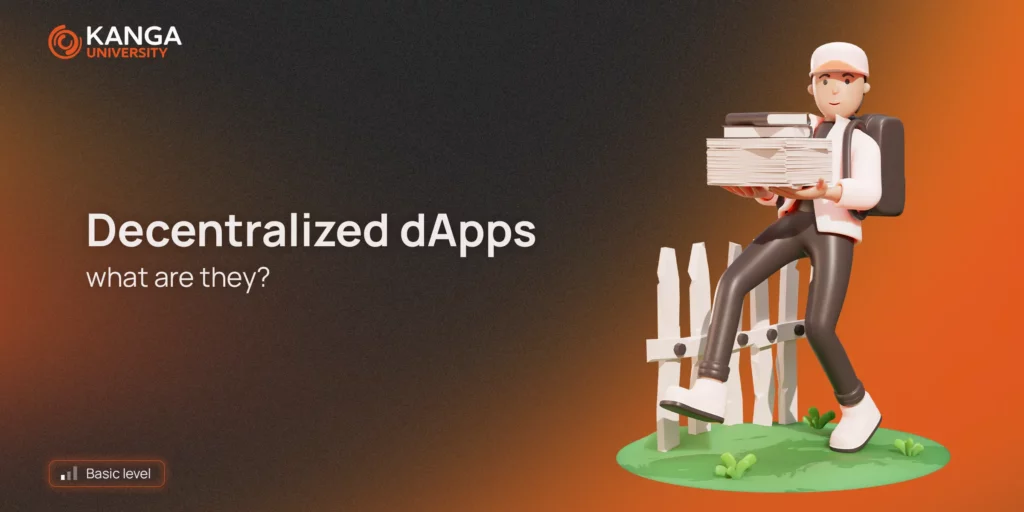
dApps are nothing more than decentralized applications. In principle, they differ little from the “normal” ones. They offer similar functions, except that they run on a Peer-to-Peer or blockchain network. The use of blockchain allows getting rid of intermediaries completely. However, we will talk about this shortly.
What are decentralized applications?
dApps – decentralized applications. Abbreviated as “dApps” or “dapps”, they are applications or programs that originated on blockchain. They work by relying on the blockchain or a network of peer-to-peer computers. They do not run on a single computer. As the name implies, they do not have an external body supervising them.
Very often they are built on a platform we all know – Ethereum. They are used for various purposes: finance, games, community building or media.
Although dApps are free from the control of individual authorities, they provide full security and privacy protection for their users.
How do dApps work?
All dApps were developed and operate on the blockchain network. They are free from third-party oversight because they are based on an open-sourced, decentralized ecosystem. For example – you want to create dApps similar to Telegram. After programming the app, you put it on blockchain. Then any of the users of the ecosystem you have created can publish messages in it. The catch, however, is that no one, not even the creator of the app, can delete these messages.
Why is this happening? Let us explain. In order for a decentralized application to be created, the developer must write it in a suitable programming language. Each dApps has its backend code running on a P2P network.
In “normal” applications, this code is located on centralized servers. Our decentralized application must also connect to smart contracts.
Remember what the most important features of smart contracts are? Here’s a refresher on the topic.
You already know from previous lessons that in order for an application to be decentralized, it must be controlled by the logic provided by our smart contract. Here are four, most important features of dApps:
- They eliminate middlemen
- They operate on an open-source system
- The data placed in the application and its records are public
- The cryptographic token provides security on the network
To make it even simpler for you to understand the functioning of dApps, we will compare them to “normal” centralized applications. The standard web applications we use every day (such as Meta) are based on a computer system. It is owned by the organization by which it is operated. At the same time, this body has full authority over the application and controls its operation. So, you can see the subtle difference.
Advantages of decentralized applications
There are quite a few of them. Most of them revolve around the privacy of the system’s users, but in the ranks of pluses we will also highlight:
- No need to send your personal information
- Decentralized applications offer a range of capabilities and features
- We do not single out a central authority
- They use smart contracts
- They are a pretty good alternative to social media
- dApps are flexible, which means they can be implemented in many industries
- They are resistant to censorship
Disadvantages of decentralized applications
Every stick has two ends, and we like to look at the topic from all sides. Let’s analyse the drawbacks of our decentralized applications:
- They are relatively young, and as a result, they pose some problems, especially regulatory ones
- No easy-to-use interface for the user
- They are not intuitive
- Data and code published on blockchain is difficult to modify. This poses a challenge to developers, who have to come up with a solution to allow changes to the code.
- Very high network maintenance costs
As dApps are a young creation, they are also vulnerable to attacks by hackers. In 2022 alone, an estimated $1.2 billion was stolen from decentralized apps during numerous cyberattacks and exploits. The most notorious was the Ronin Bridge hack, where $552 million US dollars were stolen.
To launch attacks on decentralized applications, hackers use many techniques. The most popular are exploits linked to flash DeFi loans and attacks on cross-chain bridges. These two exploits allow funds to be transferred between blockchains – quickly and anonymously.
However, less imaginative cybercriminals continue to use old-fashioned means of fraud. For example, getting members of a community to approve transactions that are harmful to the ecosystem and themselves.
dApps – examples
Searching for your dApps Grail, it’s worth going to DappRadar. It’s a website where you’ll find hundreds, if not thousands, of dApps built on Ethereum, Polygon or BNB Chain. Currently, the most popular decentralized applications are DeFi and DEX.
This will also include:
- Maker DAO, which is a decentralized lending platform;
- Cryptokitties, a game that doesn’t need to be elaborated on, as everyone from the crypto world has surely heard of it;
- Peepeth – a decentralized alternative to Twitter. There is something for everyone interested!
Summary
dApps are an entirely new model for building applications. Of course, they are a relatively young idea, but there is no shortage of ambitious developers who will want to improve the idea. Who knows, maybe in a few years decentralized apps will become as popular as Bitcoin?
It’s also worth considering that despite the early stage of development, there are already several decentralized applications that offer interesting services. They are worth looking into. In 2022 alone, the popularity of dApps was so high that it reached a whopping 2.4 million users per day!
But before decentralized applications can get on their pedestal, they will have to overcome many challenges. Including improving scalability, security, and user experience. However, we augur a bright future for the sector.